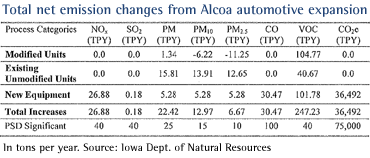by Seth Tupper, North Dakota Monitor
July 25, 2024
The medals awarded to soldiers who participated in the 1890 Wounded Knee Massacre will be subjected to a review, the U.S. Department of Defense announced Wednesday.
The department... more

The heralded expansion of Alcoa's Davenport Works will add $300 million in new construction, an estimated 150 new jobs, and a significant increase in the facility's emission of volatile organic compounds (VOC's).
The increased emission of VOC's -- which lead to the formation of ground-level ozone -- is high enough to require the company to obtain a modification in its Prevention of Significant Deterioration (PSD) permit. The plant's air quality construction permit is under review by the Iowa Department of Natural Resources (IDNR), which will hold a public meeting on the issue at 6:30 p.m., Tuesday (1/17) at the Bettendorf Public Library.
The aluminum manufacturing facility at 4879 State Street currently emits an estimated 240 tons of VOC's each year, and that would be increased by an additional 247 tons with the planned expansion announced last September.
Ground-level ozone can be harmful to breathe and damages crops, trees and vegetation. It is created by chemical reactions between oxides of nitrogen (NOx) and volatile organic compounds (VOC) in the presence of sunlight. Emissions from industrial facilities and electric utilities, motor vehicle exhaust, gasoline vapors, and chemical solvents are some of the major sources of nitrogen oxide and VOC's, according to the U.S. Environmental Protection Agency.
The Iowa Economic Development Commission is providing $3 million in incentives for the plant expansion to accommodate the expected growth in aluminum use by the automotive industry.
Scott County currently is in "attainment" for ozone levels, but both ozone and particulate matter under 2.5 microns (PM 2.5) have been a concern of local governmental agencies.
The Bi-State Regional Commission's Air Quality Task Force - a coalition of private and public entities - was formed in 2009 to address air pollution in the region. The group has developed a voluntary emissions reduction program which includes recommended activities organizations can implement to reduce their emissions and help the region remain in attainment.
Falling out of attainment would lead to requirements to develop and implement ways to lower those emissions violating the federal limits. Such a non-attainment designation also could make it more difficult to attract new industry to the region.
In its public notice, the IDNR says the increased emissions of VOC's from the Alcoa expansion aren't expected to cause a violation of the National Ambient Air Quality Standards.
In addition to the VOC emissions, the plant expansion also means higher emissions of other pollutants: PM 2.5 (6.7 tons per year), nitrogen oxide (27 tons per year), carbon monoxide (30 tons per year), particulate matter less than 10 microns (13 tons per year), and carbon dioxide, also known as greenhouse gas emissions, (36,500 tons per year).
The public can make oral statements or submit written comments at the January 17 meeting. Written comments on the permit modification will be accepted by the IDNR until January 30.
CLICK HERE to view online all material concerning the permit application and correspondence available for public inspection from the Iowa Department of Natural Resources.
CLICK HERE to download Alcoa's PSD construction permit.
by Seth Tupper, North Dakota Monitor
July 25, 2024
The medals awarded to soldiers who participated in the 1890 Wounded Knee Massacre will be subjected to a review, the U.S. Department of Defense announced Wednesday.
The department... more
Iowa Capital Dispatch
July 18, 2024
The state panel charged with ensuring transparency in government is being sued for allegedly violating Iowa’s Open Meetings Law.
Briana Reha of Polk County is suing the Iowa Public Information... more
Iowa's largest ethanol producer – POET, LLC – has agreed to fines totaling $53,000 for hazardous air emissions from its Shell Rock refinery over a two-year period.
The Iowa Department of Natural Resources (IDNR) imposed a $10,000 fine – the most the department is allowed to levy without... more
The city of Bettendorf has agreed to pay a total of $2.3 million to the victims struck by a car while they were walking on the pedestrian trail adjacent to the I-74 Bridge two years ago.
Two of the victims were killed and the third seriously injured when a drunk driver mistook the bike/... more
Powered by Drupal | Skifi theme by Worthapost | Customized by GAH, Inc.

